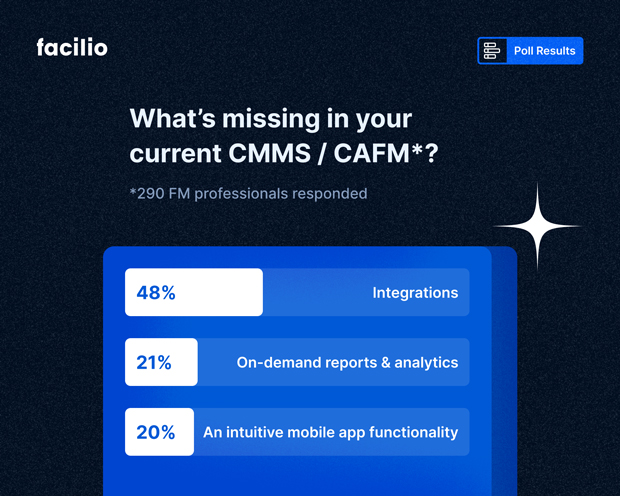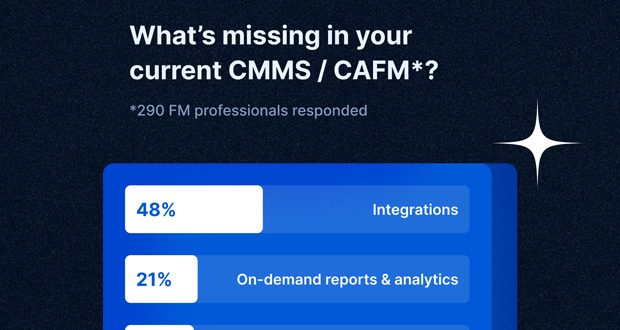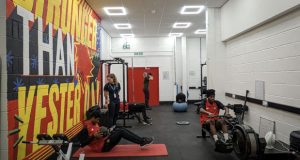
Raj Subramanian, Chief Product Officer at Facilio
A recent survey of 290 facility management professionals revealed glaring gaps in their current CAFM / CMMS tool:
- Nearly 48% of facility managers surveyed are wrestling with missing integrations.
- One in five are missing on-demand reports and analytics.
- And another 20% are stuck with a mobile app that feels like it’s from the Stone Age.
These results highlight the common frustrations among facility managers, particularly regarding systems that don’t meet today’s operational demands.
Facility management is a complex field that demands precise coordination and real-time data to keep everything, from daily maintenance routines to mandated safety inspections, running smoothly. While legacy CAFM handles the basics like service requests, they often give with one hand and take with the other.
Yes, they reduce your workload by automating routine tasks, but their rigid, outdated interfaces and multiple siloed tools force you to work around their limitations—sacrificing efficiency and productivity along the way.
Mark Hazelwood, Managing Director at Q3 Services, summed it up well when he said: “What we didn’t like about legacy tools in FM is, in reality, there wasn’t one tool. So you were having to go and buy a core application, a reporting tool, perhaps something to do apps, and then lots of point solutions to look at IoT. And that didn’t really feel very integrated and was also very complicated.”
This pretty much nails the frustration that so many in the industry feel. In today’s tech-driven world, your CAFM should be working for you, not the other way around. You shouldn’t have to bend over backwards to make your system fit your needs. Yet, many facility managers find themselves doing just that, tolerating these issues and adapting their processes to accommodate a broken system.
The bottom line? You’re settling for inefficiencies that have no place in modern facility management. Here are three key compromises facility managers are making with their current CAFM—and why you shouldn’t be making them.

1. Your O&M tools don’t talk to each other
Integration is crucial for efficient facility management, yet 48% of professionals surveyed reported that their current CAFM fails to integrate smoothly with their broader tech stack, including essential business applications for accounting, procurement, and property management.
Integrations are often far from straightforward, typically requiring third-party consultants like Deloitte or Infosys to build custom APIs that enable these systems to communicate. This adds significant costs and introduces many unforeseen layers of complexity.
The problem: Legacy CAFM tools were never built to be integrable. Their scope ended at asset and maintenance management. For the FM use cases that are the norm today, legacy tools with patchwork point solutions are as holistic and scalable as building a rocket with duct tape and a prayer.
The financial burden extends beyond the initial integration. With each new tool your CAFM can’t natively integrate with, you’re forced to either pay substantial fees to third-party developers or invest in additional integration services from CAFM providers.
We’ve seen FM teams juggling up to 20 different systems – can you imagine the time and money wasted just trying to get them to talk to each other?
Moreover, relying on third-party vendors for integration means you’re subject to their timelines, not your own. Any delays in integration can push back your implementation schedule, which delays the project’s time to RoI.
A modern CAFM, by contrast, offers seamless, out-of-the-box integration with your existing software. No more costly workarounds or endless waiting. Real-time connectivity across all your operations means you’re always in the driver’s seat.
2. Forced to fly blind in a data-driven world
Data is king, yet 21% of the facility managers we surveyed said their CAFM is sorely lacking in on-demand reporting and analytics features.
FM Service Providers juggle data from multiple internal and client systems and fragmented vendor reports. Once the raw data is in hand, they still require dedicated resources—Power BI developers or data specialists—to translate those numbers into actionable insights, even for daily metrics. This complicates daily reporting and increases the lag between when issues arise and when they can be addressed.
So, whether you’re tracking SLA completion rates, planned vs. reactive maintenance ratios, or vendor adherence to SLAs, your hands are tied. Without real-time data access, you’re stuck flying blind, unable to make proactive adjustments to prevent costly downtime or improve asset performance.
An upgraded CAFM solves these challenges by bringing data together from various systems into one platform. It offers real-time reporting and customized dashboards, enabling FMSPs to quickly access performance metrics like Mean Time to Repair (MTTR), budget expenditure, and vendor performance. With actionable insights at your fingertips, you can reduce downtime, streamline operations, and improve client satisfaction.
3. Mobile access limitation cripples you on the field
Facility management is inherently mobile, with teams constantly moving between sites to address issues and perform routine maintenance. However, one out of five facility managers report that their current CAFM doesn’t offer the mobile functionality they need. This limitation is a significant hindrance in a field where work is done on the go.
Think about the daily responsibilities of a maintenance technician who needs to complete work orders, log asset conditions, or respond to emergency repairs. Without mobile access, technicians must return to a desktop to update tasks, wasting valuable time and delaying response times for critical equipment failures or tenant service requests.
Legacy systems with mobile solutions primarily designed for field service teams like technicians and contractors fall short of providing accessibility to other stakeholders.
Switching to a modern CAFM designed with a mobile-first approach means every stakeholder—from technicians to facility managers—can access and update data in real-time, no matter where they are.
This level of accessibility ensures that your team can stay agile, quickly responding to issues as they arise and keeping operations running smoothly. It’s about giving your team the tools they need to be effective wherever the job takes them.
The data speaks: CAFM compromises are sabotaging your operations
If you’ve found yourself nodding along, recognising these compromises in your own work, it’s time to ask a simple question: Why settle?
Just because you’re used to your current CAFM doesn’t mean it’s the best option. You deserve a system that works exactly the way you need it to, one that doesn’t make you choose between getting the job done and doing it well.
Outdated CAFM systems create inefficiencies that ripple across all aspects of facility management, from data integration and reporting to mobility and response times.
It’s time to demand more from your CAFM—because when your tools fall short, so does your ability to deliver top-notch results. If your current CAFM fails to deliver on these fronts, you must upgrade to a system that meets your needs rather than one that forces you to work around its limitations.
By Raj Subramanian, Chief Product Officer at Facilio.
For more information please visit https://facilio.com/





